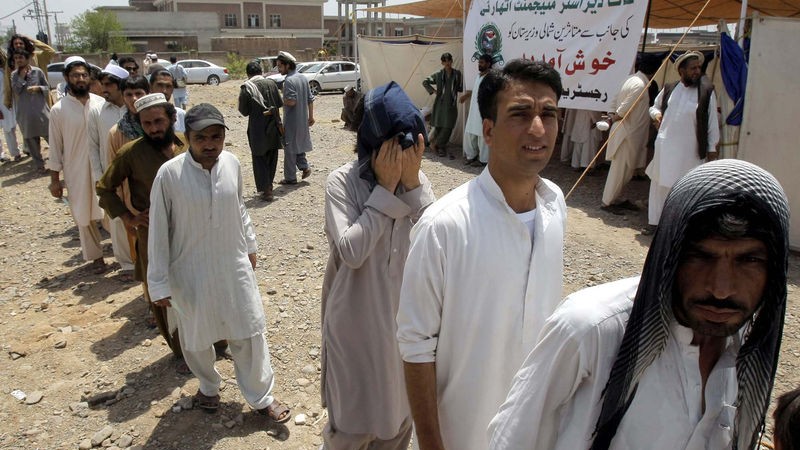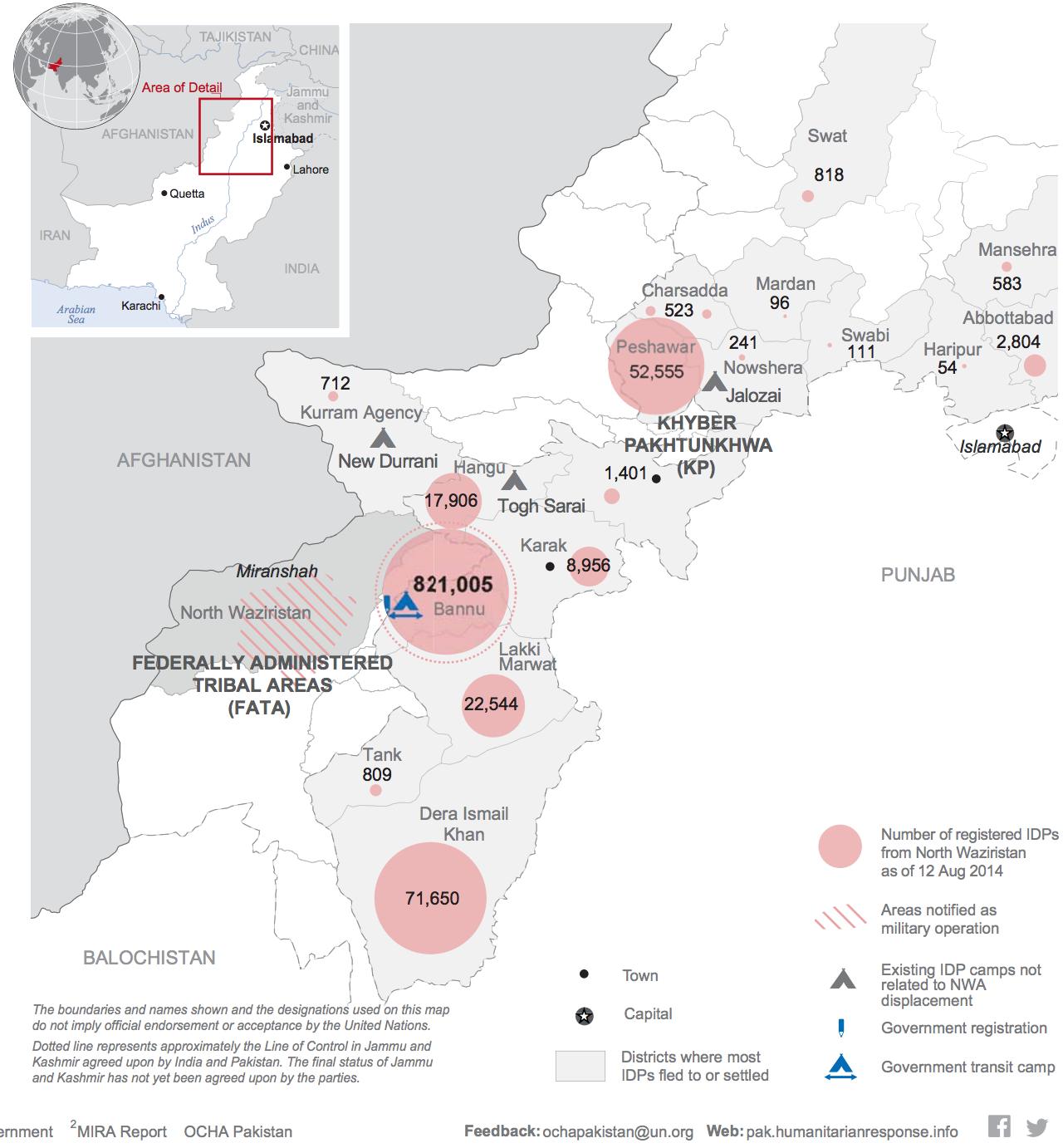 [1]
[1]Internally displaced people from North Waziristan are at registration camp in Peshawar. Image by ppiimages. Copyright Demotix (8/7/2014)
Tens of thousands of anti-government protesters have been staging demonstrations in the capital Islamabad and the ensuing political crisis [2] has captivated and monopolized the Pakistani media's attention since mid-August.
At the same time, the Pakistani press has scarcely covered how an ongoing military operation has forced a million people from their homes [3] in North Waziristan, near the border with Afghanistan.
US-based Pakistani Twitter user Zainab Abdullah writes:
Pakistan is at war, has over a million IDP's, homeless, hungry and abandoned. yet all eyes and hearts are on the capital – sad
— Zainab Abdullah (@AbdullahZainab) September 2, 2014 [4]
The Pakistani army launched Operation Zarb-e-Azb [5] in mid-June, attacking several camps, including some that belonged to Tehrik-e-Taliban Pakistan (TTP) [6] and Islamic Movement of Uzbekistan (IMU) [7], who claimed responsibility for an attack on the international airport in Karachi [8].
The first phase of the operation included intensified airstrikes in North Waziristan, targeting militant training facilities, hideouts, and other infrastructure. After the first airstrikes, at least 457,000 people [9] reportedly fled their homes. The air strikes continued and according to latest reports [3] by the UN's OCHA the number of internally displaced persons (IDPs) from that region has risen to more than one million people.
This flood of IDPs was added to the 690,000 people [10] already living in protracted displacement in the country, some since 2004, some because of previous military operation against the Taliban in the region and some because of disastrous floods [11].
Pakistan's government was unprepared [12] for this humanitarian crisis. In fact, there are allegations that some government-run refugee camps are empty [13], while IDPs elsewhere, sustained only by local samaritans, endure miserable conditions. Minorities, it is reported, are sometimes ignored [14] entirely. Officials in the province of Sindh cite budgetary constraints for failing to accommodate IDPs from the Khyber Pakhtunkhwa province. Many IDPs have also encountered [15] a gruelingly slow registration process, followed by poor distribution of relief supplies. Indeed, the list of irregularities [16] and health concerns affecting IDPs [17] is long.
Different groups in Pakistan, including opposition parties [18], have worked to communicate IDPs’ grievances to the national government. The government in Islamabad, however, has downplayed the scale of the disaster. On July 10, Pakistan's foreign office refused to request international assistance, calling the rehabilitation of the country's displaced persons an internal matter [19]. However, they are allowing aid agencies consisting of UN and humanitarian partners under the umbrella of Humanitarian Country Team (HCT) [20] to raise fund and provide vital humanitarian assistance to support 500,000 IDPs for six months. So far, the donors have pledged or contributed only 25% of the required $99 million fund, and in the meantime the number of IDPs exceeded 1 million.
Some authorities in the displaced communities are growing impatient with the government's relief efforts. A tribal leader from North Waziristan, for example, recently threatened [21] to march to Islamabad, if that's what it takes to gain the country's notice.
 [22]
[22]Relief Goods consignment from Pakistan Army being dispatched for IDPs of North Waziristan. Image by ppiimages. Copyright Demotix (3/7/2014)
On August 14, the political parties of cricketer-turned-politician Imran Khan [23] and Sufi scholar and politician Tahir-ul-Qadri [24]—Pakistan Tehrik-e-Insaaf (PTI [25]) and Pakistan Awami Tehreek (PAT [26]), respectively—staged political marches against the government in Islamabad. Their charges against the government are various: electoral rigging in 2013 general elections [27], corruption, nepotism, and the killing of innocent people, just to name a few. The groups’ demands include, but are not limited to, the resignations of Prime Minister Nawaz Sharif [28] and the chief minister of Punjab, Shehbaz Sharif [29].
The demonstrations began as peaceful sit-ins in front of the parliament building. On August 30, however, violent clashes [2] broke out between police and protesters. To date, three people have been killed, and many more are injured.
Since the start of the marches, Pakistani news channels have run marathon telecasts [30] devoted narrowly to the political crisis outside the Parliament in Islamabad. The media has ignored almost entirely Pakistan's ballooning IDP population.
Sherry Rehman [31], a former information minister and ambassador to the US, encouraged Pakistan's media to “grow up” and do more reporting about the country's IDP catastrophe.
If the Pk media really wants to start growing up it must make better editorial choices.Give half a window to IDPs in marathon pol telecasts
— sherryrehman (@sherryrehman) August 17, 2014 [32]
Pakistan's TV news has ignored other important events recently, as well, like the death of more than 15 people [33] in heavy rains last month, and an attack by the Taliban [34] on an airbase in Quetta, in western Pakistan.
Like many concerned Pakistanis, Hafsa Khawaja, a student in Lahore, addressed the mainstream media on Twitter, asking journalists to rethink their reporting and devote more attention to the country's ignored tragedies.
It would be nice if the media gives even half of the attention it is giving to this chaos, to those suffering, ignored Pakistanis. #IDPs [35]
— Hafsa Khawaja (@Hafsa_Khawaja) August 20, 2014 [36]
Several journalists have also complained about the media's apparent disregard for Pakistani IDPs. Even before the marches, Nasim Zehra [37], a prominent television anchor and newspaper columnist, was already asking if the capital's politics were promoting indifference about Pakistan's humanitarian crisis. Zehra addressed not only the country's politicians, but the “royal we” within the mass media:
In the high stake political drama in Pakistan, how much are the IDPs ignored? Lets ask ourselves,r govts & r political parties.
— Nasim Zehra (@NasimZehra) August 11, 2014 [38]
According to Faizan Lakhani, some parents have even started naming their children born in refugee camps after the camps’ names.
#AzbKhanEnclosure [39], IDP's camp area where “Azb Khan” was born last week is named “Azb Khan enclosure” #IDPs [35] #Pakistan [40] pic.twitter.com/o1rq3M1UV4 [41]
— Faizan Lakhani (@faizanlakhani) July 7, 2014 [42]
Memeabad [43], a famous satire-based Facebook page with more than 64,000 followers, announced in a post:
JUST IN: Boy born in the IDP camps of Bannu. Parents named him Azb ‘Stop fucking ignoring us we're suffering for you people’ Khan.
Here as elsewhere online, the Memebad post's underlying message, laden with frustration and anger, is that Pakistanis show terrible indifference to their suffering compatriots.
Fakhr-e-Alam [44], an important figure in Pakistan's entertainment industry, expressed his disappointment with the country's handling of refugees in the north.
In the last 2 weeks or so i have heard nothing bout IDPs, Zarb e Azb, India aggression,minorities killings, law & order etc from any leader.
— Fakhr-e-Alam (@falamb3) August 29, 2014 [45]
Understandably, displaced communities are also disappointed in the government's relief efforts. Despite the inherent dangers of life in North Waziristan, many IDPs are even asking the state to present a timeframe for the end of its Zarb-e-Azb operation [46], so they can return to their homes and find some relief.
